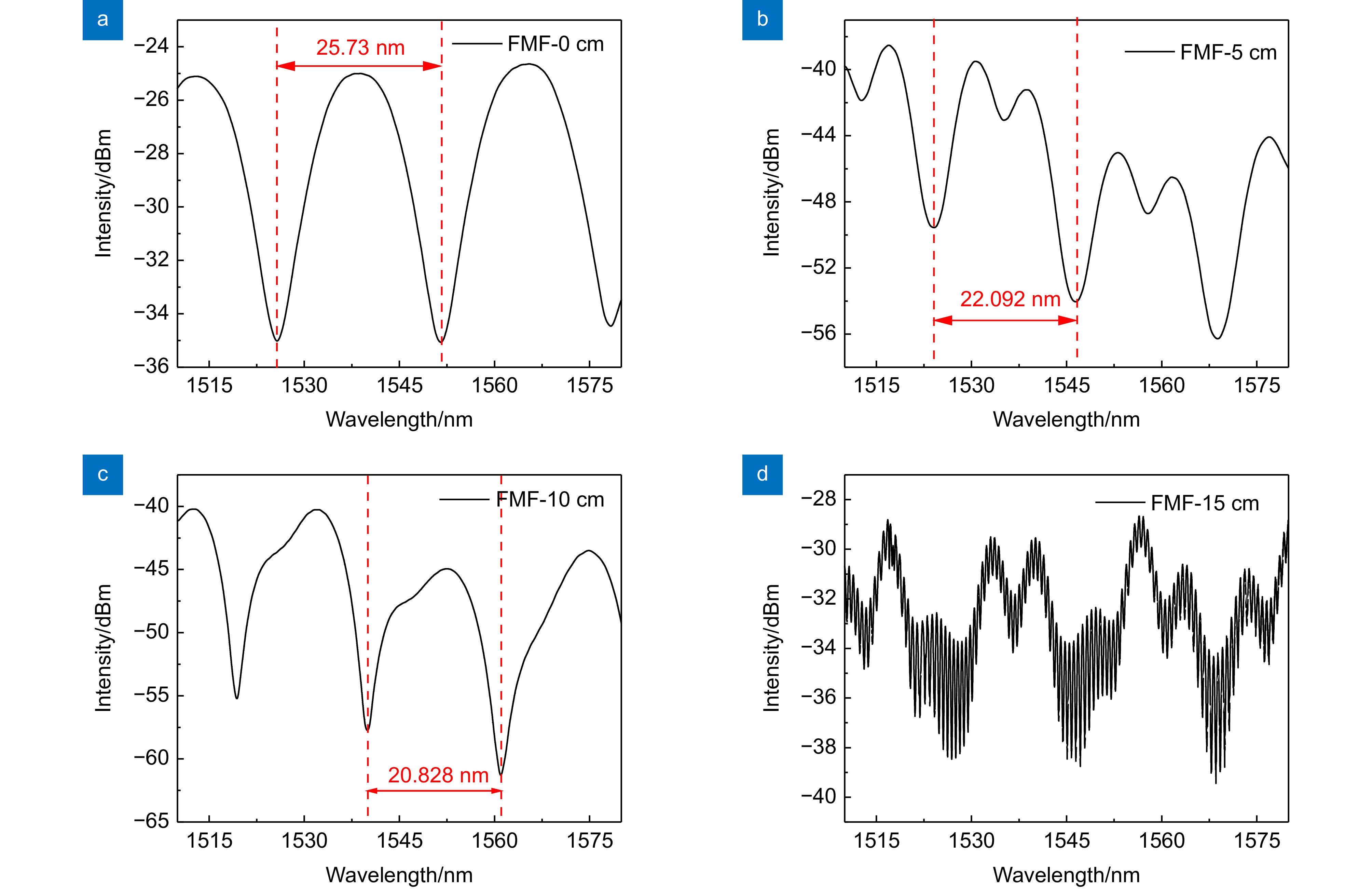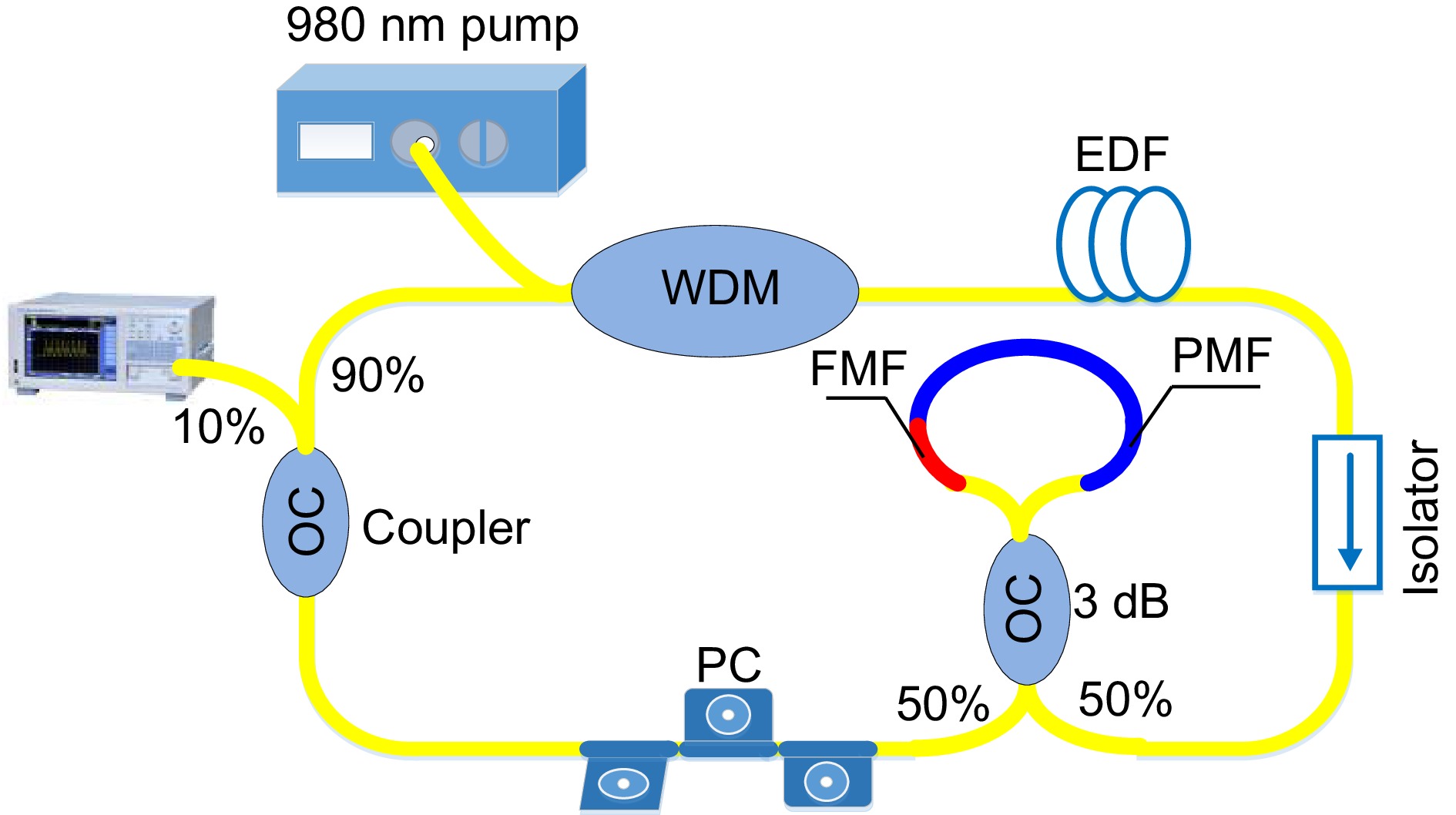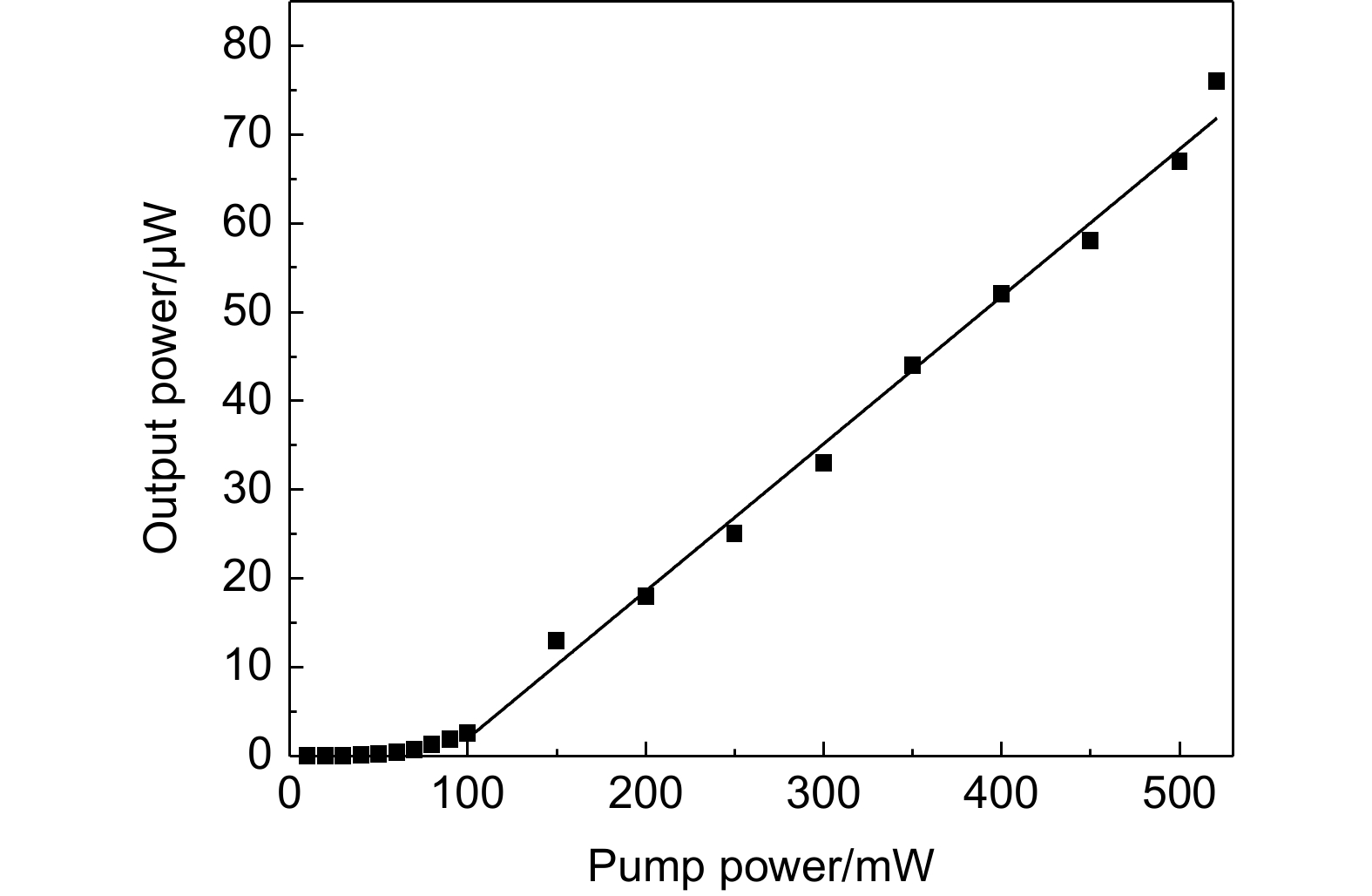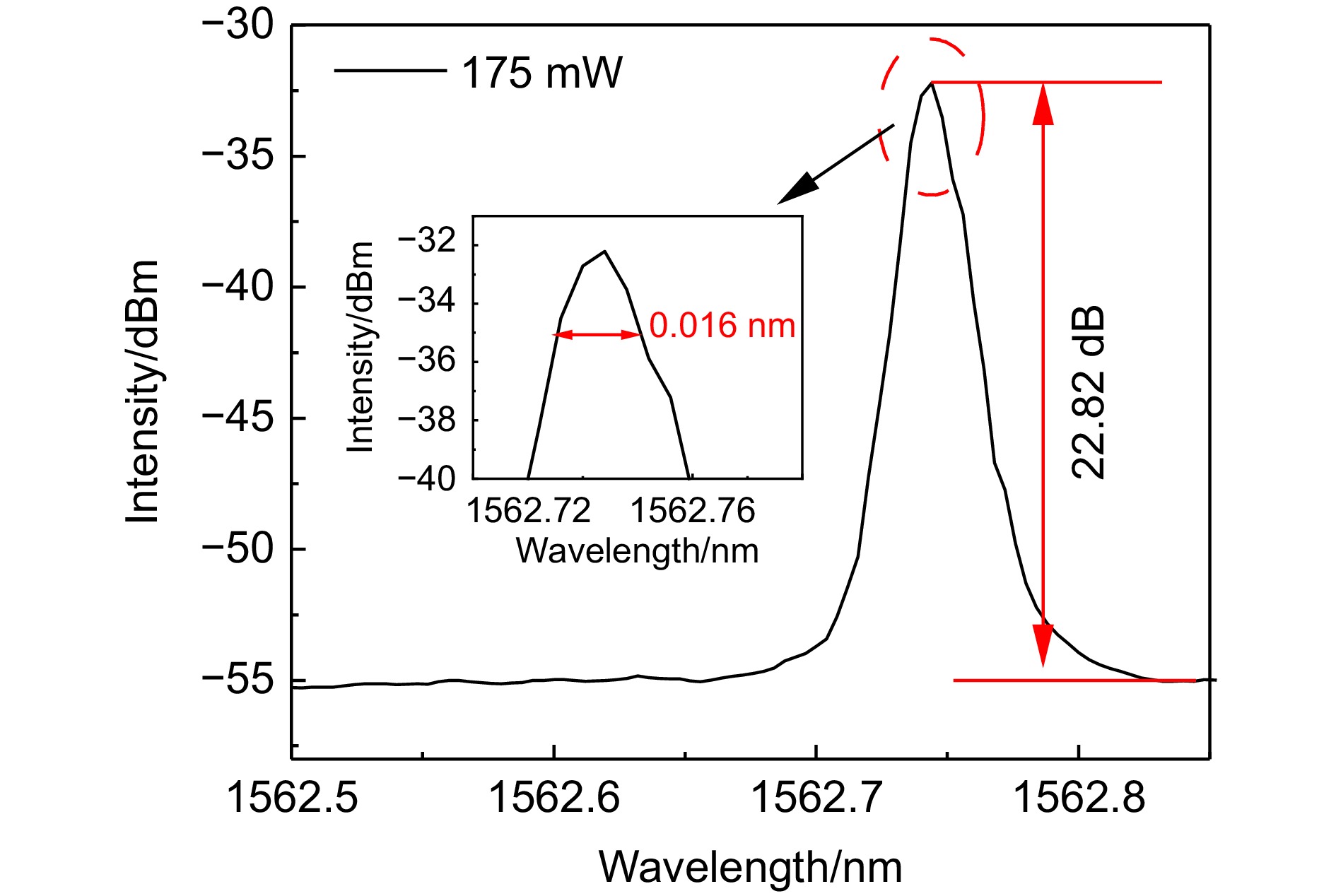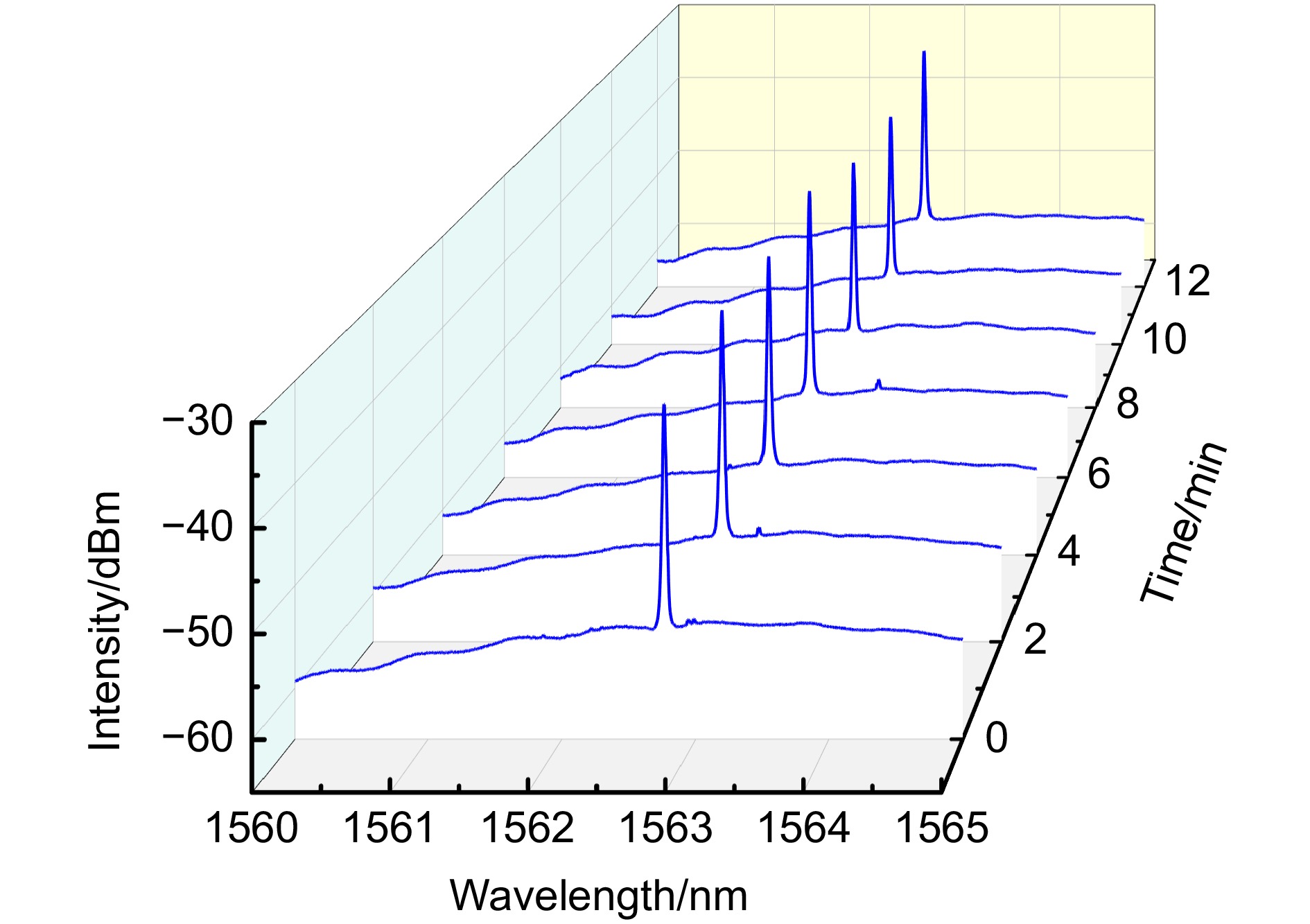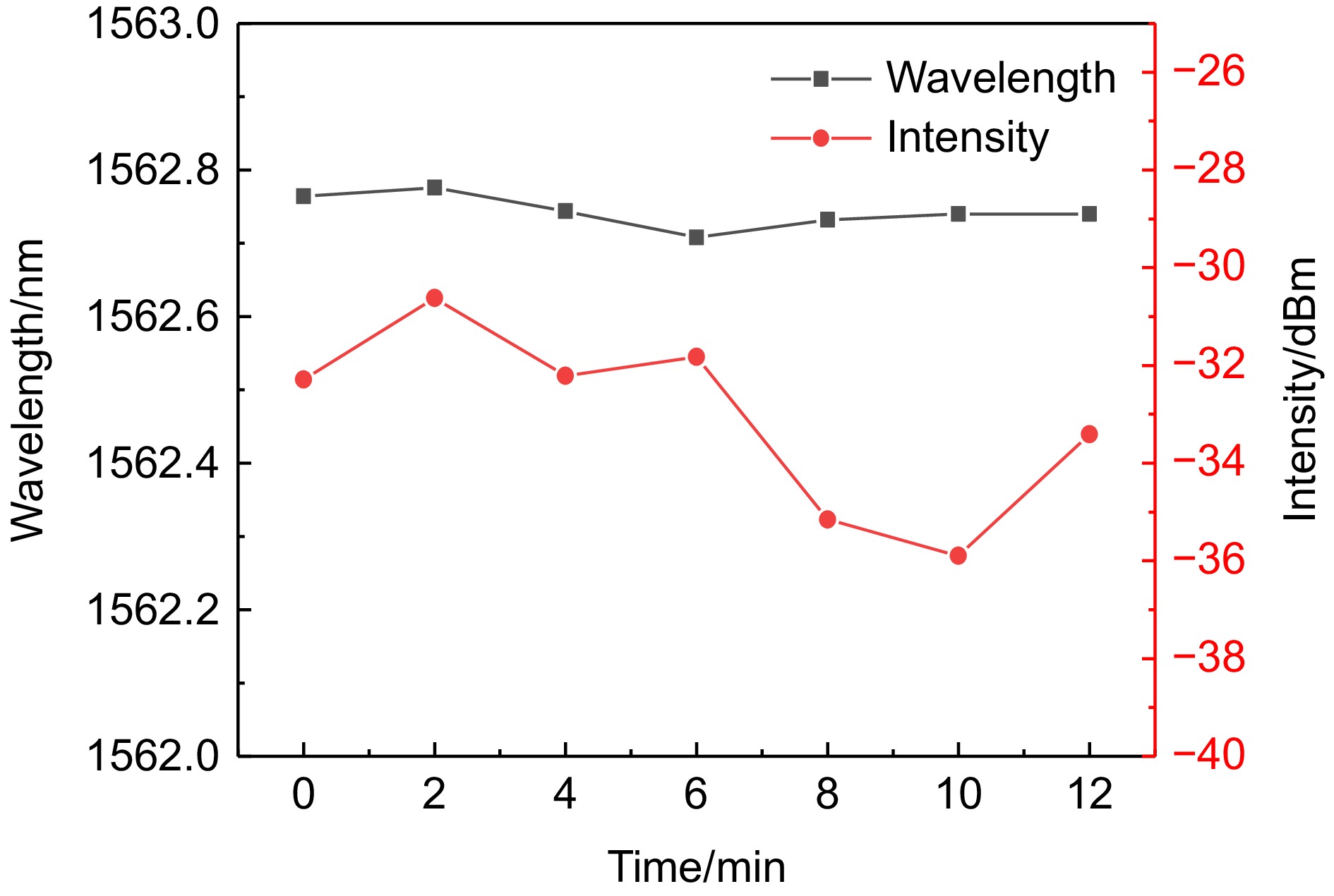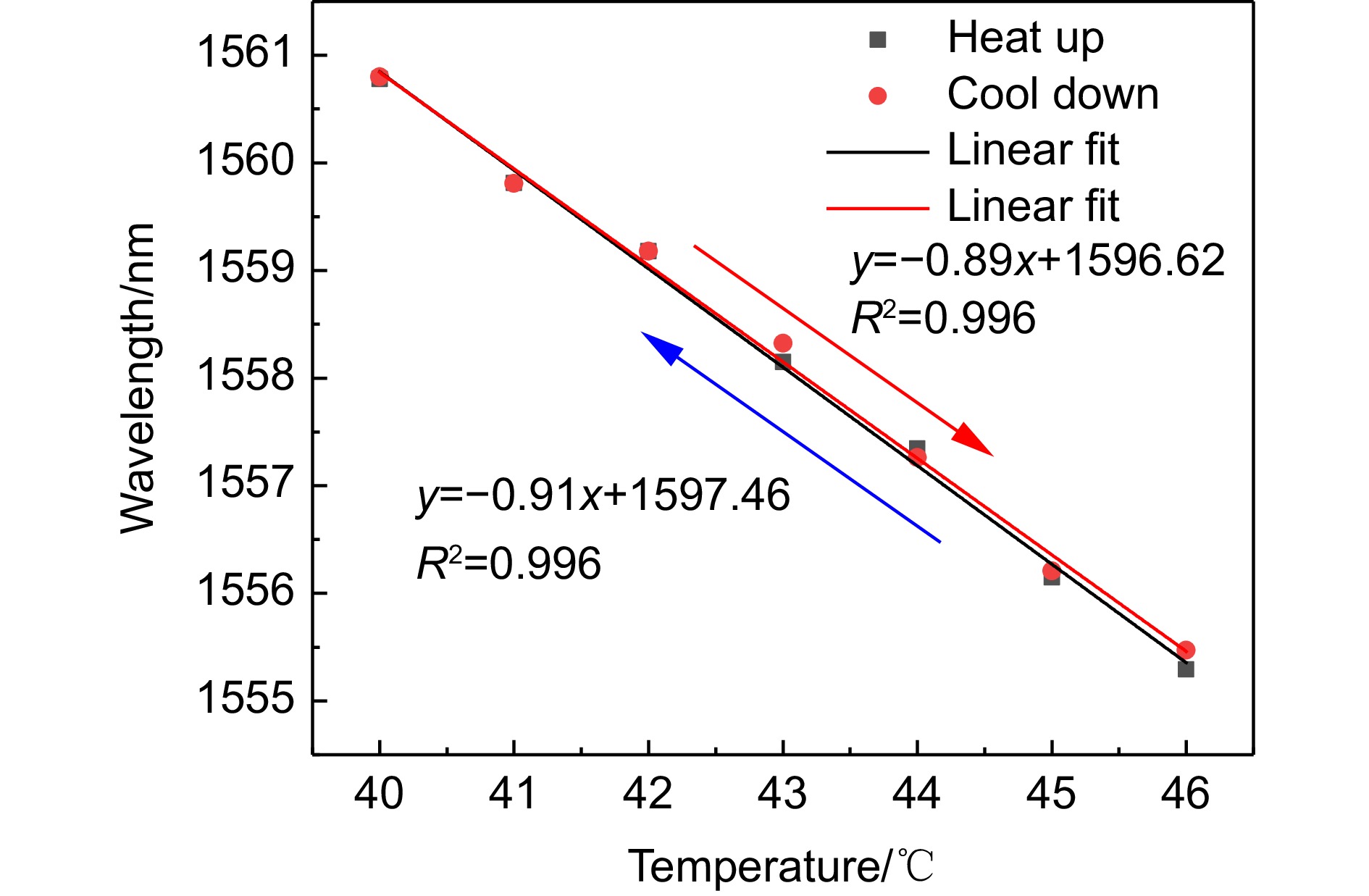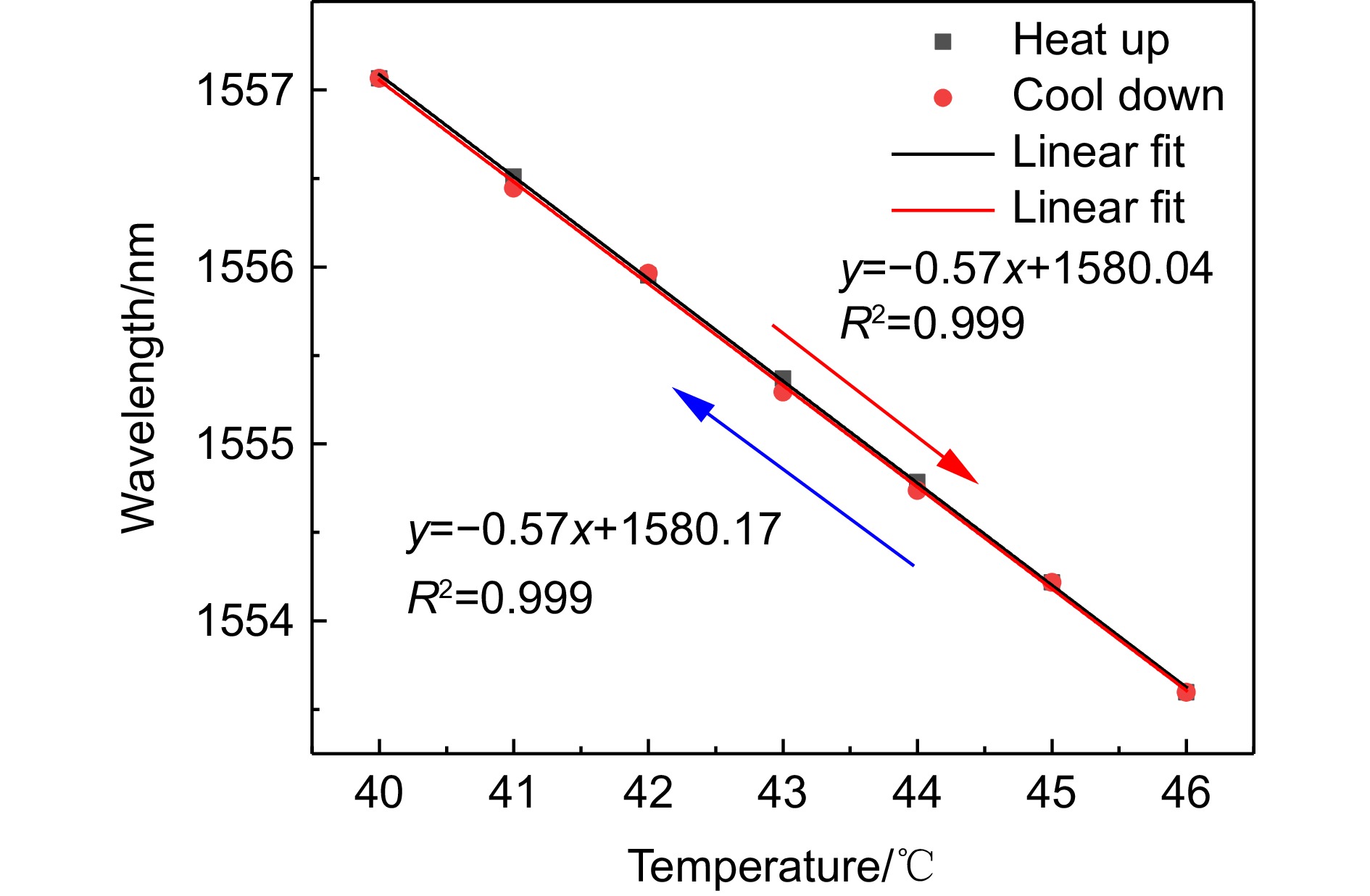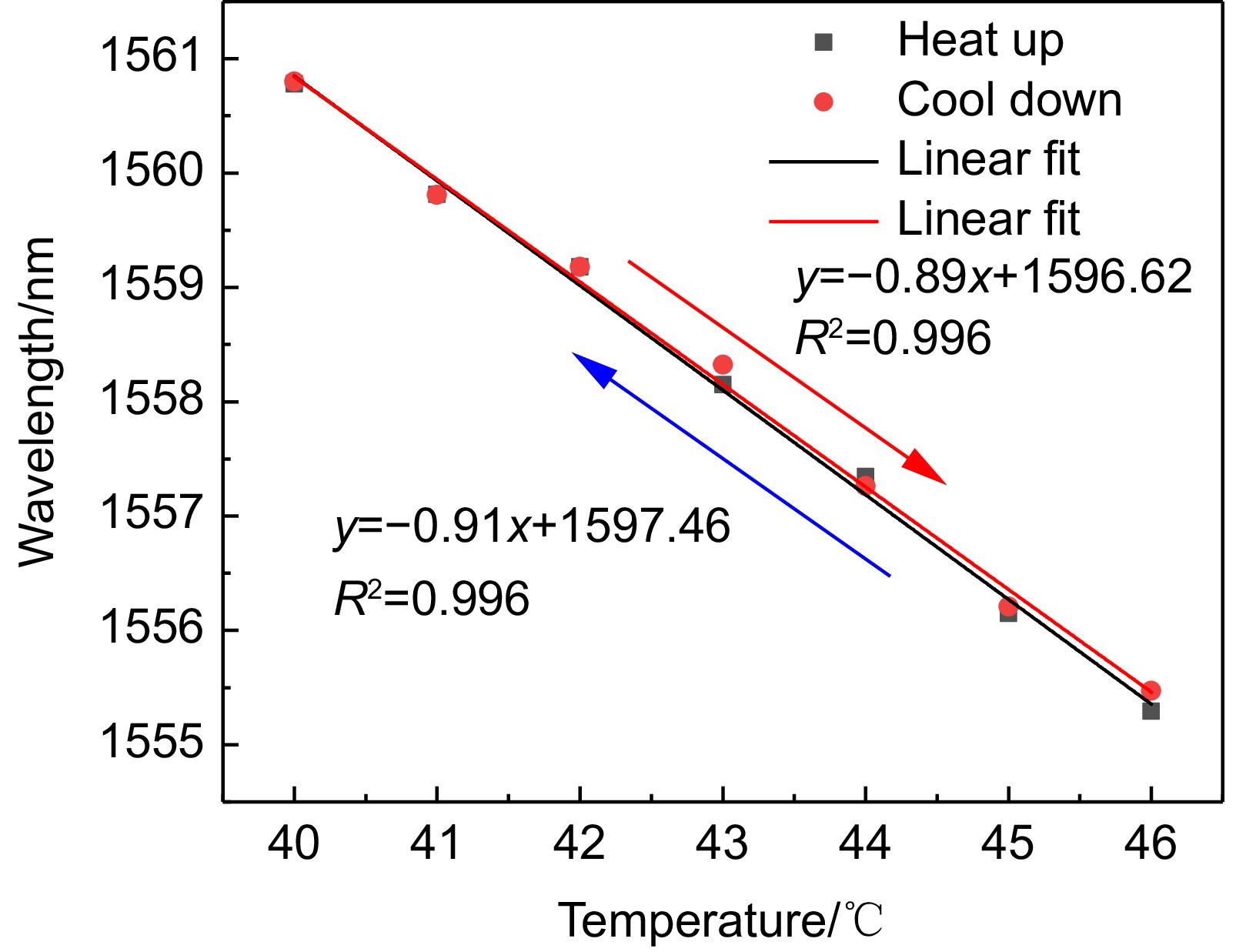Laser temperature sensor based on polarization maintaining fiber and few mode fiber
-
摘要:
本文提出了一种基于保偏光纤与少模光纤的激光温度传感器,并对其进行了实验研究。将20 cm的保偏光纤与10 cm的少模光纤熔接在一起,之后与3 dB耦合器组成Sagnac环,作为传感探头。光经过少模光纤激发出高阶模,由于少模光纤与保偏光纤直径不匹配,高阶模与纤芯模耦合到保偏光纤的应力区,激发出包层模,从而提高温度灵敏度。实验结果表明,加入少模光纤后,传感器的温度灵敏度从−0.51 nm/℃提高到−0.91 nm/℃。该传感器具有精度高、制造方便、本质安全等优点,在工程结构安全监测中具有广阔的应用前景。
Abstract:This paper proposes a laser temperature sensor based on polarization maintaining fiber (PMF) and few-mode fiber (FMF), and conducted their experimental studies. A 20 cm polarization maintaining fiber was spliced with a 10 cm few-mode fiber and then combined with a 3 dB coupler to form a Sagnac loop, which served as the sensing probe. Light passing through the FMF excites higher-order modes. Due to the diameter mismatch between the FMF and PMF, the higher-order modes are coupled into the stress region of the PMF, exciting the cladding modes and thus improving temperature sensitivity. Experimental results show that after adding the FMF, the temperature sensitivity of the sensor increased from −0.51 nm/℃ to −0.91 nm/℃. This sensor has the advantages of high precision, easy fabrication, and intrinsic safety, making it highly promising for engineering structure safety monitoring applications.
-
Overview: As we all know, temperature has always been an important parameter in physics, and various tools have been used to measure temperature. In recent decades, fiber optic interferometers have been widely used in temperature measurement. Traditional fiber optic interferometers include the Mach-Zehnder interferometer (MZI), Fabry-Perot interferometer (FPI), Michelson interferometer (MI), and fiber optic Sagnac interferometer (FSI). Meanwhile, fiber optic ring lasers have advantages such as high sensitivity, good stability, low insertion loss, and high signal-to-noise ratio, leading to the combination of fiber optic interferometers with fiber optic ring lasers. Among these, the FSI has advantages of low noise, reciprocal dual optical paths, and higher temperature sensitivity compared to MZI and FPI, thus being widely used in temperature measurement.
This paper proposes a laser temperature sensor based on polarization-maintaining fiber (PMF) and few-mode fiber (FMF) and conducts experimental research on its sensing characteristics. A 20 cm PMF is spliced with a 10 cm FMF, then combined with a 3 dB coupler to form an FMF-PMF Sagnac ring as a temperature sensor. Light passing through the FMF excites higher-order modes, and due to the diameter mismatch between the FMF and PMF, the higher-order modes and core modes couple into the stress region of the PMF, exciting cladding modes and thereby enhancing temperature sensitivity. In the temperature sensitivity measurement experiment of the FMF-PMF Sagnac ring, the temperature range from 40 ℃ to 46 ℃ with a step size of 1 ℃, maintaining each temperature for about 10 minutes, after which the output spectrum is recorded by a spectrum analyzer. Experimental results show that as the temperature increases, the single peak wavelength shifts to shorter wavelengths (blue shift), caused by the reduction in the birefringence difference between the PMF core mode and cladding mode and the effective refractive index difference between the FMF fundamental mode and higher-order mode, with a temperature sensitivity of −0.91 nm/℃ and a fitting curve fit degree of 0.996. As the temperature decreases, the single peak wavelength shifts to longer wavelengths (red shift), caused by the increase in the birefringence difference between the PMF core mode and cladding mode. At the same time, the effective refractive indexes are different between the FMF fundamental mode and higher-order mode, with a temperature sensitivity of −0.89 nm/℃ and a fitting value of 0.996. The temperature sensitivity of the PMF-Sagnac ring fiber laser temperature sensor is −0.57 nm/℃. Thus, it can be seen that with the addition of FMF, the temperature sensitivity of the FMF-PMF Sagnac ring fiber laser temperature sensor is increased by 1.6 times.
-

-
表 1 与先前报道文献的传感器性能对比分析
Table 1. Performance analysis of the proposed probe with that reported in literature
-
[1] Liu Y X, Li X G, Zhang Y N, et al. Fiber-optic sensors based on Vernier effect[J]. Measurement, 2021, 167: 108451. doi: 10.1016/j.measurement.2020.108451
[2] Wu T G, Liu G W, Fu S G, et al. Recent progress of fiber-optic sensors for the structural health monitoring of civil infrastructure[J]. Sensors, 2020, 20(16): 4517. doi: 10.3390/s20164517
[3] Fan L, Bao Y. Review of fiber optic sensors for corrosion monitoring in reinforced concrete[J]. Cem Concr Compos, 2021, 120: 104029. doi: 10.1016/j.cemconcomp.2021.104029
[4] Zheng Y, Zhu Z W, Xiao W, et al. Review of fiber optic sensors in geotechnical health monitoring[J]. Opt Fiber Technol, 2020, 54: 102127. doi: 10.1016/j.yofte.2019.102127
[5] Lei X Q, Dong X P, Sun T, et al. Ultrasensitive refractive index sensor based on Mach-Zehnder interferometer and a 40μm fiber[J]. J Lightwave Technol, 2021, 39(17): 5625−5633. doi: 10.1109/JLT.2021.3087037
[6] Gao Z G, Feng Y H, Chen H L, et al. Refractive index and temperature sensing system with high sensitivity and large measurement range using an optical fiber[J]. IEEE Trans Instrum Meas, 2023, 72: 9502706. doi: 10.1109/TIM.2023.3237224
[7] Zhao L, Wang J Q, Li Z, et al. Quasi-distributed fiber optic temperature and humidity sensor system for monitoring of grain storage in granaries[J]. IEEE Sens J, 2020, 20(16): 9226−9233. doi: 10.1109/JSEN.2020.2989163
[8] Qin Z G, Qu S, Wang Z Q, et al. A fully distributed fiber optic sensor for simultaneous relative humidity and temperature measurement with polyimide-coated polarization maintaining fiber[J]. Sens Actuators B Chem, 2022, 373: 132699. doi: 10.1016/j.snb.2022.132699
[9] Fedorov A Y, Kosheleva N A, Matveenko V P, et al. Strain measurement and stress analysis in the vicinity of a fiber Bragg grating sensor embedded in a composite material[J]. Compos Struct, 2020, 239: 111844. doi: 10.1016/j.compstruct.2019.111844
[10] Dong L G, Gang T T, Bian C, et al. A high sensitivity optical fiber strain sensor based on hollow core tapering[J]. Opt Fiber Technol, 2020, 56: 102179. doi: 10.1016/j.yofte.2020.102179
[11] Cui Y, Jiang Y, Liu T M, et al. A dual-cavity Fabry–Perot interferometric fiber-optic sensor for the simultaneous measurement of high-temperature and high-gas-pressure[J]. IEEE Access, 2020, 8: 80582−80587. doi: 10.1109/ACCESS.2020.2991551
[12] Lu J Y, Yu Y, Qin S P, et al. High-performance temperature and pressure dual-parameter sensor based on a polymer-coated tapered optical fiber[J]. Opt Express, 2022, 30(6): 9714−9726. doi: 10.1364/OE.452355
[13] Liu Y G, Feng Y P, Wen J L, et al. Integrated fiber-optic sensor based on inscription of FBG in seven-core fiber for curvature and temperature measurements[J]. Opt Fiber Technol, 2023, 75: 103197. doi: 10.1016/j.yofte.2022.103197
[14] Braunfelds J, Senkans U, Skels P, et al. FBG-based sensing for structural health monitoring of road infrastructure[J]. J Sens, 2021, 2021(1): 8850368. doi: 10.1155/2021/8850368
[15] Wang Y, Tong R J, Zhao K J, et al. Optical fiber sensor based on SPR and MZI for seawater salinity and temperature measurement[J]. Opt Laser Technol, 2023, 162: 109315. doi: 10.1016/j.optlastec.2023.109315
[16] Gao S, Ji C K, Ning Q Y, et al. High-sensitive Mach-Zehnder interferometric temperature fiber-optic sensor based on core-offset splicing technique[J]. Opt Fiber Technol, 2020, 56: 102202. doi: 10.1016/j.yofte.2020.102202
[17] Liu S T, Zhao S X, Liu Q W, et al. Ultrahigh-resolution and ultra-simple fiber-optic sensor with resonant Sagnac interferometer[J]. Opt Lett, 2023, 48(13): 3543−3546. doi: 10.1364/OL.489379
[18] Ge Q, Zhu J H, Cui Y Y, et al. Fiber optic temperature sensor utilizing thin PMF based Sagnac loop[J]. Opt Commun, 2022, 502: 127417. doi: 10.1016/j.optcom.2021.127417
[19] Guo J H, Lian S P, Zhang Y, et al. High-temperature measurement of a fiber probe sensor based on the Michelson interferometer[J]. Sensors, 2021, 22(1): 289. doi: 10.3390/s22010289
[20] Shao M, Zhang R, Zhao X, et al. Dual-core fiber based in-line Michelson interferometer for humidity sensing[J]. Opt Fiber Technol, 2021, 64: 102570. doi: 10.1016/j.yofte.2021.102570
[21] Liu Y G, Wen J L, Feng Y P, et al. Miniaturized high-sensitivity temperature sensor based on cascaded fiber-optic FPI[J]. IEEE Photonics Technol Lett, 2023, 35(8): 430−433. doi: 10.1109/LPT.2023.3251412
[22] Liang J Q, Yu Y, Bian Q, et al. Metal-coated high-temperature strain optical fiber sensor based on cascaded air-bubble FPI-FBG structure[J]. Opt Express, 2023, 31(10): 16795−16811. doi: 10.1364/OE.489420
[23] Liu B, Zhang H. Polarimetric distributed Bragg reflector fiber laser sensor array for simultaneous measurement of transverse load and temperature[J]. Opt Fiber Technol, 2011, 17(6): 619−625. doi: 10.1016/j.yofte.2011.09.002
[24] Han S X, Yan J Y, Cao C F, et al. Single-mode GaSb-based laterally coupled distributed-feedback laser for CO2 gas detection[J]. Chin Phys B, 2023, 32(10): 104205. doi: 10.1088/1674-1056/accff2
[25] Feng D Q, Tang Y X, Lei R, et al. A Polarimetric fiber ring laser incorporating a coupled optoelectronic oscillator and its application to magnetic field sensing[J]. Photonics, 2023, 10(6): 662. doi: 10.3390/photonics10060662
[26] Liang L J, Ren G B, Yin B, et al. Refractive index and temperature sensor based on fiber ring laser with STCS fiber structure[J]. IEEE Photonics Technol Lett, 2014, 26(21): 2201−2204. doi: 10.1109/LPT.2014.2350151
[27] Lin W H, Zhou S J, Shao L Y, et al. In-fiber Mach–Zehnder interferometer based on Er doped up-taper and peanut-shaped fiber structure in fiber ring laser[J]. IEEE Access, 2021, 9: 128126−128132. doi: 10.1109/ACCESS.2021.3112171
[28] Sanchez-Gonzalez A, Perez-Herrera R A, Roldan-Varona P, et al. A dual-wavelength fiber laser sensor with temperature and strain discrimination[J]. Sensors, 2022, 22(18): 6888. doi: 10.3390/s22186888
[29] Lin W H, Liu Y H, Shum P P, et al. In-line Mach Zehnder interferometer based on ytterbium doped fiber with up-taper structure in fiber ring laser and its application in sensing[J]. Sensors, 2022, 22(23): 9196. doi: 10.3390/s22239196
[30] Liu B W, Shirahata T, Ye G Y, et al. Hybrid wavelength manipulation with enhanced ambient-thermal adaptability in an all-polarization-maintaining mode-locked fiber laser[J]. J Lightwave Technol, 2024, 42(9): 3376−3384. doi: 10.1109/JLT.2024.3351769
[31] 陈志萌, 黄昌清, 朱庆超, 等. 基于游标效应的萨格纳克干涉仪温度传感器[J]. 半导体光电, 2023, 44(6): 845−850. doi: 10.16818/j.issn1001-5868.2023081002
Chen Z M, Huang C Q, Zhu Q C, et al. Temperature sensor of cascaded sagnac interferometer based on vernier effect[J]. Semicond Optoelectron, 2023, 44(6): 845−850. doi: 10.16818/j.issn1001-5868.2023081002
-


 E-mail Alert
E-mail Alert RSS
RSS
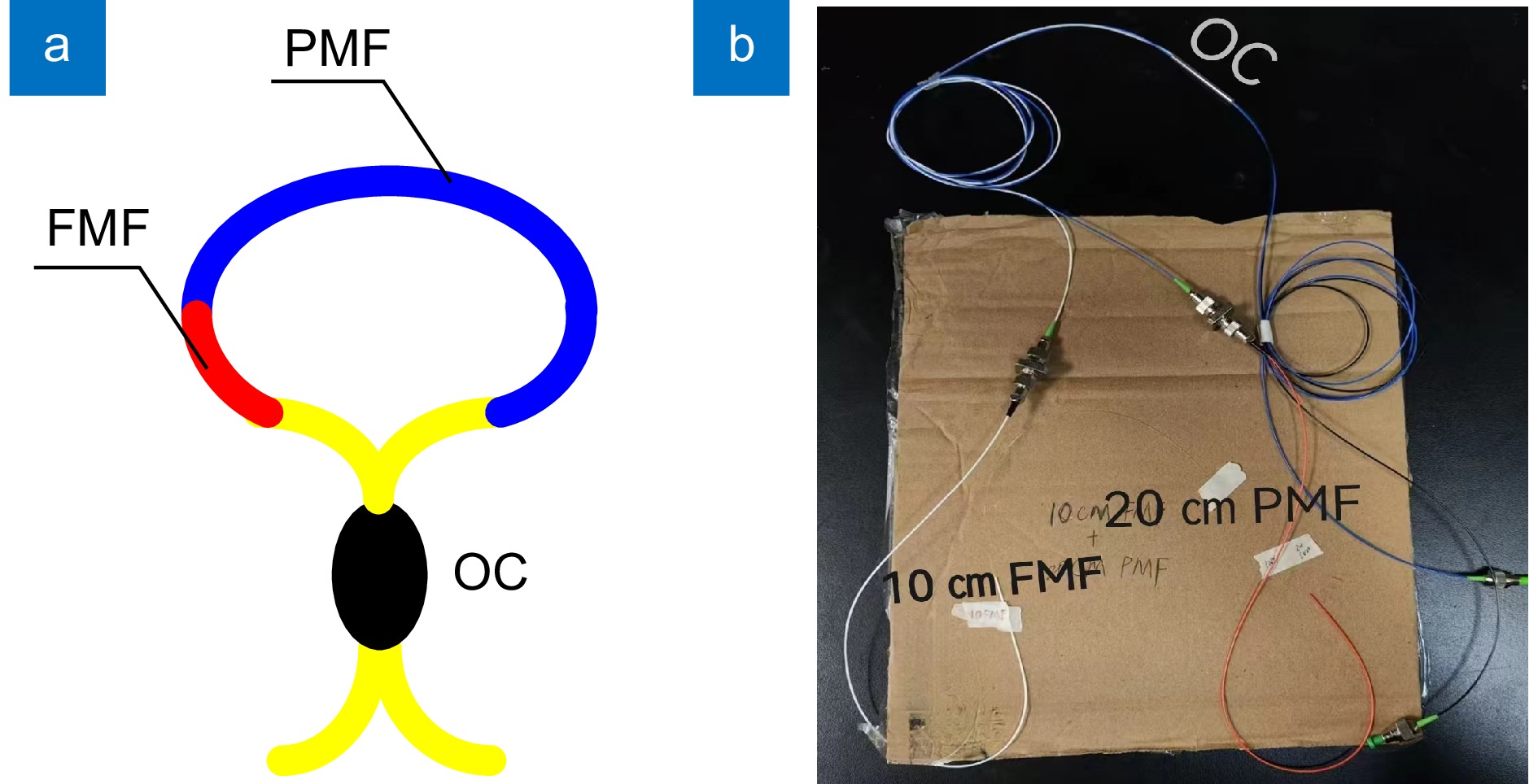
 下载:
下载:
